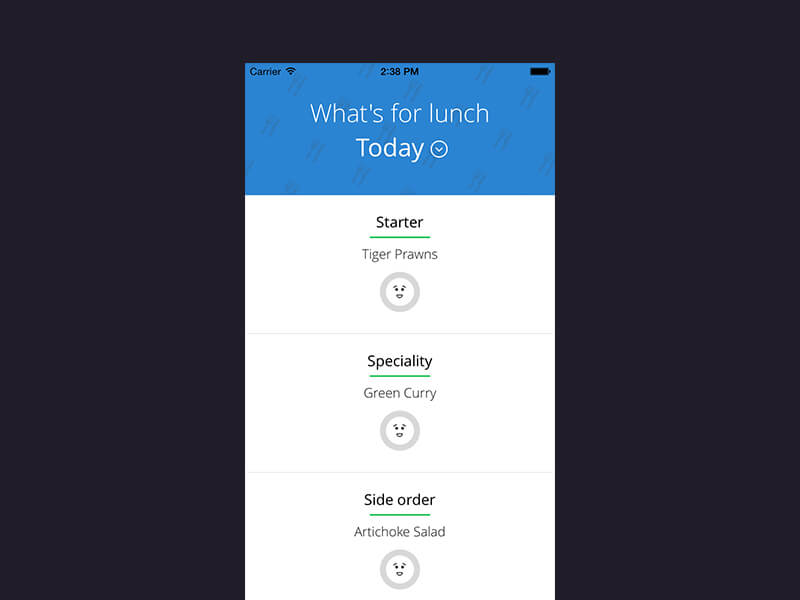10 UX Lessons I Learned from Building Our Office Lunch App
Once in a while we all come up with new ideas for apps that would solve small or large problems based on a personal or professional pain point. Taking this a step further, I’ve always thought it would be a great learning experience to take one of my ideas through to a finished product. Hopefully through fleshing out an idea, I could answer questions such as: Is this idea so great after all, once the novelty wears off? Does this digital product truly cover an actual user need? Is this need large enough to warrant an entire digital product? Do my UI design decisions hold water and is the product easy to navigate and a joy to use? I’m a designer who has taught myself how to code iOS apps, so I thought it would be fun to create an app from scratch, learning a ton of things going through all the concept, design and development phases of the digital product.
Meet Lunchie
I work as a UX designer at FFW, a global digital agency headquartered in Copenhagen. One day, our global creative director had an idea: why don’t we make an app that tells us what’s for lunch? Although the idea was simple, I really liked it. We get lunch delivered by an external catering company and the menu changes on a daily basis. Every Monday we get the menu for the whole week, but in a clunky PDF format thats difficult to open on your phone. Let’s do something about that!

We could create a fun, easy-to-use lunch app that on a rudimentary level would tell people what’s for lunch, but also facilitate an atmosphere of fun by getting people talking about food, what dishes they look forward to, their favourite foods and so on. The app could really encourage a sense of community. And potentially we could add a lot of fun features, such as voting for dishes, a wish list, emojis etc.
The lunch app idea ticked a lot of boxes, and so Lunchie was born. And along with Lunchie came a great deal of learnings. So what did I learn?
Lessons
1. Carrying out an idea is scary
Having an idea is fun. In your head it’s this awesome being that’s going to take over the world. Everyone will erupt with pure joy, and it’s sure to be the next big thing. Once you start executing your idea, you also start judging it for what it is and what it isn’t. You might even figure out it’s not going to work. But that’s also okay. At least that means you’ve learned something.
2. Don’t try to do everything yourself
Teaching myself the basics of the Swift language has allowed to code my own simple apps, gaining a valuable understanding of the inner workings of code. Constantly having to switch between the high-level concept and UX and the minute details of code is tough and occasionaly made me lose sight of the over-all vision. You really need at least one other person to give feedback and help you reflect on the over-all product decisions.
3. Nothing beats observing people using your product
You’ll learn a ton of things watching how people interact with your product. Chances are it’s nowhere near how you intended it. Maybe they love a feature, that almost didn’t make it. Maybe they aren’t interested in the product at all or maybe they can’t figure out the navigation.
4. Providing value to others feels amazing
Observing how code can change, or at least improve people’s lives, is really powerful. Watching how you’ve made someone’s day just a little bit easier feels really good.
5. Nothing is more important than clear navigation
If your users can’t navigate the app or find the content they’re looking for, they’re going to quit the app and not come back.
6. People are busy and will occasionally forget about your product
We’re all busy and tend to forget things, services, apps, etc. Your users are going to need reminders about your product. With Lunchie we implemented push notifications to remind people about lunch (and the app’s existence.)
7. Listen to your users, they‘ve got great feature ideas
It’s the people using your app everyday, that are naturally going to come up with clever, smart ways of using your product or features that would make it better. Listen to them.
8. Can your product stand the trial of everyday use?
Using your product for a long period of time is going to reveal different insights to just test it while building it.
9. Your product needs to be maintained
Most products need to be maintained. If it’s an app, eventually you are going to have to upgrade your app to a newer OS. Maybe your app feeds off some sort of information that needs to be maintained by someone in a database somewhere. Plan for this, and keep it in mind. I quite frankly didn’t think too much about the fact that someone needs to update the app on a weekly basis with the newest version of the lunch menu.
10. Your product is never finished
There is no such thing as a finished product. Contexts and circumstances evovle. Things and people change. Your product is a living organism that exists because it solves an issue. If issues or needs change, your product needs to change too.
11. Endless possibilities (Bonus Lesson)
Once you get started, you get so many ideas. What if we could sell the app to our catering company, or to all catering companies in Denmark? If we include a dish voting system, the catering company would know which dishes were particular popular and through this optimize their offerings. We could also add a dish wishlist, or emojis to allow people to express their excitement or disappointment in a fun, quirky way. As you get to spend time with your product, new ideas come popping in to your head. Ideas you wouldn’t otherwise have thought of. Win!
I’d do it again
Creating Lunchie from scratch was incredibly fun and exciting but also a lot of hard work. I learned a ton and now have a better understanding of all the different cogwheels that make a digital product. I’d do it again. In fact I will do it again.
What do you think?
I’d love to hear your thoughts on creating digital products for your own use. Comment below or get in touch!

